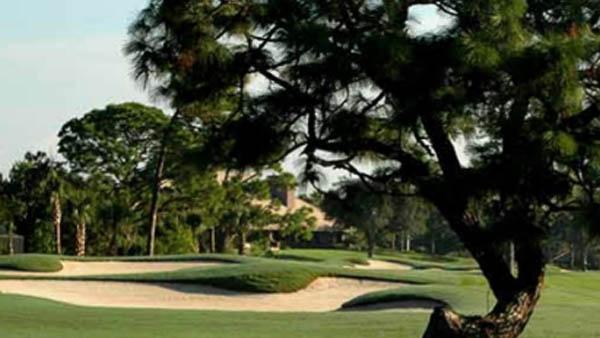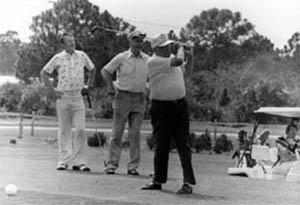Larry Hirsh could have starred as the straight man in one of those old satirical V-8 commercials when he provides his unwitting costar with a bit of clarity in which they experience one of those "aha" moments. You know the kind of moment I'm talking about; the opportunities that are staring you in the face, but you never recognized them until someone else comes along to point them out.
 Indeed, Larry has a very different and unique relationship with the game of golf and the rest of the industry.
Indeed, Larry has a very different and unique relationship with the game of golf and the rest of the industry.As a lifelong golfer, his love for the game is obvious to anyone who meets him. He is a current or past member at some of the finest clubs in the country, and he possesses an A-game. He knows and appreciates the history of the game and the contributions of superintendents who make the golf experience what it is. He runs in Brad Klein's circle, and that alone is enough for me.
As the principal of his own company, Golf Property Analysts, Larry also offers an array of consulting services for those looking to buy or sell golf courses, including those that are in financial distress.
To Larry, as well as the rest of us who rely on the game to provide a roof over our heads and something to eat at the end of the day, the struggles facing the golf industry are the ugly side of an otherwise great business.
About a million people a year are finding something else to do with their time, and thus courses have been closing at a brisk clip for a decade now. It's a disturbing trend that shows no sign of slowing anytime soon.
A colleague and long-time veteran of the golf business recently told me "the fun is gone from this business."
That might be overstating things just a bit, but it underscores the fact that at every turn, it's just a lot harder today to make a go of it in golf than it was 15-20 years ago.
 Still, we've become largely immune to the doom-and-gloom news every year of how many courses have closed, how many people quit the game, older folks are carrying the game and millennials aren't playing.
Still, we've become largely immune to the doom-and-gloom news every year of how many courses have closed, how many people quit the game, older folks are carrying the game and millennials aren't playing.Battling through the bad news is the dues we pay to stay in the game. The cost of doing business.
Golf course closures are just business. Cold and impersonal. But every once in awhile, the grim reaper of golf steps forward and claims a property that pulls at the heartstrings. And I have Larry to thank for reminding me that it's not all just business; that there is a personal side to this as well.
Recently, Larry's e-newsletter told the tale of a golf course that soon will close, but it wasn't just any golf course. Blue Ridge Country Club in Harrisburg, Pennsylvania was the course he grew up playing, the course where he taught the game to his children.
Here is a snippet from Larry's newsletter: "The club I grew up at, where I learned the game from my father, taught my sons the game, won and lost club championships, made friends and some foes, went to weddings and bar-mitzvahs and spent many idle hours shooting the breeze in the pro shop, on the patio or in the bar, Blue Ridge Country Club in Harrisburg, PA will be shutting its doors in favor of mixed development at the end of the 2017 season."
Courses will come and go, but there is no replacing memories like that.
The story reminded me of my own personal golf course casualty.
My dad has been gone a long time, 29 years to be exact. I had just picked up the game shortly before he was diagnosed with cancer, so we played together a little bit, but not much. The golf course, however, was where I got to know his fill-in, my father-in-law.
My wife's father was another A-gamer. He's still with us, but his health now prevents him from playing, or doing much of anything else for that matter. To this day, I have a deep bond with him, and it's one that was largely formed on the fairways of Dodger Pines Golf Club in Vero Beach, Florida.
J.L. is as tough as they come. He's survived multiple bouts with cancer and heart problems, and even though he's in his 80s, I'm convinced he could still kick my ass . . . if he could just catch me. That toughness was forged in a hardscrabble life as a child in upstate New York. College football was his ticket to a future. And it's one he didn't waste. He remembered where he came from and knew he didn't want to go back. He became a success in business, raising a family of five kids who never wanted for anything.
That hard road through life made him tough and confident, and those traits made him a great golfer.
Each spring when he left Florida to return home to Ohio, he'd won enough men's club events that he usually went home with half the pro-shop's inventory in the backseat of his car.
 Dodger Pines was a great place to forge a relationship and learn about the game's history. The course was located across the street from the Dodgertown baseball complex that once was the spring training home of the L.A. Dodgers. Celebrities of every kind - Hollywood icons, professional athletes from other sports - often could be spotted here, and their photographs still adorn the walls of the quaint restaurant located at the town's tiny airport located within walking distance of Dodgertown, at that time the only place east of Los Angeles where one could buy a Dodger dog.
Dodger Pines was a great place to forge a relationship and learn about the game's history. The course was located across the street from the Dodgertown baseball complex that once was the spring training home of the L.A. Dodgers. Celebrities of every kind - Hollywood icons, professional athletes from other sports - often could be spotted here, and their photographs still adorn the walls of the quaint restaurant located at the town's tiny airport located within walking distance of Dodgertown, at that time the only place east of Los Angeles where one could buy a Dodger dog.Even long after he retired from baseball in 1966, former Dodger pitching great Sandy Koufax was a regular at Dodger Pines.
The stories there poured forth from the bar like beer out of the tap, like the tale of the 660-yard third hole that was converted from a par-5 to par-6 only because former Dodgers owner Walter O'Malley never could make par there.
I always knew my father-in-law was tough, a throwback to another era. But it was at Dodger Pines where I learned it best.
There were countless examples, but none more defining than the day when a tee shot on a back nine par-5 went astray. Buried deep in the woods, J.L. had the narrowest of windows through which he could escape. On the other side was the green, about 225 yards away. He looked over his situation and laughed saying "I need a pretty good shot here, don't I?" I watched in amazement as he hit his ball on a line-drive with a 5-wood off a bed of pine needles through a gauntlet of pine trees to within 5 feet of the flag. When he putted out for eagle, I knew I was out of my league . . . on several levels.
Dodger Pines closed in 2002, long before the golf business started on its roller coaster ride to hell. The casualty of a revolving door of Dodger owners, the course was sold for real estate development to some speculator who had designs on turning it into a mixed-use property that would include retail and residential space.
It was a bad idea in a town already starving for quality daily fee golf.
Financing never materialized, then shortly thereafter the economy tanked. There never was any high-end retail, or posh condominiums built there. Before you knew it, Dodger Pines had become a weed field, an eyesore.
Gone were the memories and the history that can never be rewritten. And for what? Nothing. It took that letter from Larry Hirsh to stir this emotion again after years of being jaded by this course closing and that course closing its doors.
Maybe that colleague was right after all. Maybe the fun is gone from this business after all.

